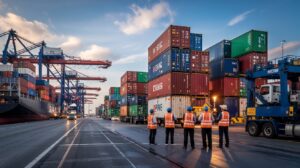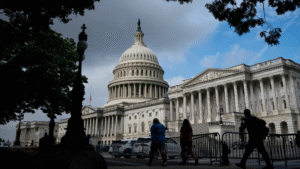Wall Street tumbles amid economic data shock – recession fears loom as new economic indicators point to the first U.S. economic contraction since 2022, leaving investors, analysts, and everyday Americans wondering whether a deeper financial downturn is on the horizon.
U.S. GDP Shrinks for the First Time Since 2022 – Why It Matters
In the first quarter of 2025, the U.S. economy contracted by 0.3%, signaling a possible shift in the post-pandemic recovery momentum. This was driven largely by:
- Surging imports ahead of expected tariffs, which reduce GDP
- Slower government spending and investment
- Weaker-than-expected output in manufacturing and construction
This unexpected decline shows that although consumer spending remained steady, other critical areas of the economy have slowed—raising alarm bells among economists.
How the Markets Reacted: Major Indexes Drop Sharply
The disappointing data sent shockwaves through Wall Street. Here’s how the markets moved in reaction:
- S&P 500 fell by 2.1%, breaking a six-day rally
- Dow Jones dropped over 700 points
- Nasdaq Composite slid 2.5%, weighed down by tech losses
Many publicly traded companies, including Starbucks and Super Micro Computer, reported poor earnings, accelerating investor concerns and sell-offs.
Summary of Economic Indicators and Their Impact
| Indicator | Latest Value | Impact on Economy and Markets |
|---|---|---|
| GDP Growth (Q1 2025) | -0.3% | Sign of contraction and potential recession risk |
| Core PCE Inflation (Mar 2025) | 3.5% | Suggests inflation remains sticky |
| Dow Jones | -700 points | Reflects investor fears and institutional sell-off |
| S&P 500 | -2.1% | Market-wide decline, loss of momentum |
| Nasdaq | -2.5% | Tech sector particularly hard-hit |
Inflation Still Rising: Could Stagflation Be Next?
The Core PCE Index, a key inflation gauge for the Federal Reserve, rose 3.5% in March 2025, a level far above the Fed’s 2% target. This persistent inflation—despite slowing growth—raises concerns about stagflation, a rare but damaging economic condition marked by:
- Slow or negative GDP growth
- High inflation
- High unemployment
If stagflation takes hold, it could lead to lower real wages, rising costs, and greater pressure on small businesses across the U.S.
Tariff Anxiety Returns: Business Behavior Shifts Ahead of Trump-Era Trade Moves
Businesses rushed to import goods in Q1 before a potential revival of Trump-era tariffs. These preemptive moves inflated import volumes, which are subtracted from GDP calculations—further dragging down growth.
Economists say this “import rush” is a direct response to uncertainty around trade policy, which remains a top concern for U.S. manufacturers, retailers, and logistics providers.
Key Forces Behind Wall Street’s Drop
Wall Street Drop (Q1 2025)
├── Economic Contraction (-0.3%)
│ └── Driven by import surge, less gov’t spending
├── Inflation Rises (3.5%)
│ └── Core PCE remains elevated
├── Trade Policy Uncertainty
│ └── Businesses react to possible tariffs
├── Earnings Misses
│ └── Starbucks, tech companies report poor Q1
└── Investor Sentiment Weakens
└── Fears of stagflation and prolonged slowdown
Analysts Lower Growth Forecasts as Recession Talk Grows
Following the release of Q1 data, many top investment firms—including Goldman Sachs and Morgan Stanley—downgraded their forecasts for Q2. Some now predict growth below 1%, while others warn of two consecutive quarters of decline, which would meet the technical definition of a recession.
According to the Conference Board, consumer confidence also fell sharply in April, with inflation and job stability being the top two concerns among surveyed households.
How This Impacts Everyday Americans
This isn’t just Wall Street news—this is Main Street reality:
- Consumers may see higher prices persist even as job growth slows
- Investors and retirees risk portfolio losses if markets remain volatile
- Small businesses face tighter credit and increased import costs
- First-time homebuyers could be squeezed by interest rate policy swings
What the Federal Reserve Might Do Next
The Federal Reserve is now in a difficult position. On one hand, inflation remains above target. On the other, growth is slowing.
Economists expect the Fed to pause interest rate hikes for now, but if inflation doesn’t ease by mid-2025, the central bank may have no choice but to raise rates again—risking a deeper recession.
Conclusion: The Path Ahead Is Uncertain – Prepare Accordingly
The combination of negative GDP growth, persistent inflation, tariff fears, and falling stock prices paints a complex picture. While a full recession is not guaranteed yet, the risk is growing. With households tightening budgets and businesses facing headwinds, the economy may be entering a fragile period that requires careful policy management and personal financial planning.
Staying informed and prepared is more important than ever.
[USnewsSphere.com / po.]





